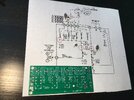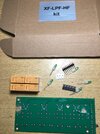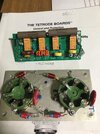I scrapped the messy rotary switch inside blower box in favor of a relay switched, parallel inductance to RF ground for driving the grid-driven tetrodes. I re-purposed a four (4) band LPF board to reduce lead length and add a nice ground plane for the connections & components.
The LPF board is available as both a kit form and fully assembled. I got the kit so I could modify the board and replace the supplied inductors with the ones I already verified as working. I’m omitting 80m which is an easy add-on if wanted later.
The pcb is 2-sided with the bottom being a large ground trace except for the thru-hole component points. I used a Dremel to remove trace material where needed. Lots of room as half the original inductors are omitted. Each band will have it’s own .01uF cap to ground so I can use small components.
Board will need only 4 connections: Ground, RF In, bias V In and bias V Out. A simple wire will parallel the relays to joins with the bias V at tube grids. Small enough to fit inside tube deck. Every connection except ground will be screw-tightened posts soldered with a spot of epoxy for strain relief. Ground will be solid wire soldered both ends.
My entry-level soldering station finally died. Yet, that’s good thing as needed a better one. Not a big jump-up but a step in the right direction. Hopefully delivery will be soon.
The LPF board is available as both a kit form and fully assembled. I got the kit so I could modify the board and replace the supplied inductors with the ones I already verified as working. I’m omitting 80m which is an easy add-on if wanted later.
The pcb is 2-sided with the bottom being a large ground trace except for the thru-hole component points. I used a Dremel to remove trace material where needed. Lots of room as half the original inductors are omitted. Each band will have it’s own .01uF cap to ground so I can use small components.
Board will need only 4 connections: Ground, RF In, bias V In and bias V Out. A simple wire will parallel the relays to joins with the bias V at tube grids. Small enough to fit inside tube deck. Every connection except ground will be screw-tightened posts soldered with a spot of epoxy for strain relief. Ground will be solid wire soldered both ends.
My entry-level soldering station finally died. Yet, that’s good thing as needed a better one. Not a big jump-up but a step in the right direction. Hopefully delivery will be soon.



